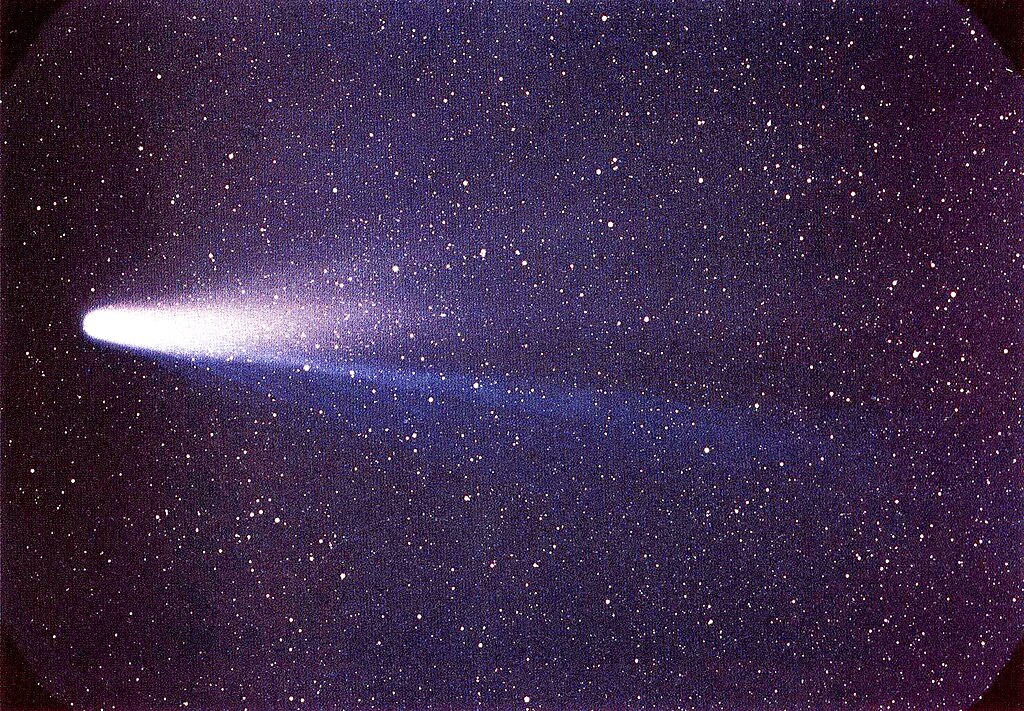
Photograph of Halley's Comet taken during its last close approach to Earth, on 1986 March 8. Until recently, it was thought that Halley's Comet was the parent of both the Eta Aquarid Meteor Shower in early May and the Orionid Meteor Shower in late October. However, 1986 observations of Halley's Comet now suggest that the Eta Aquarids may not come from Halley's Comet, but the Comet may perturb the Eta Aquarids.
(Image Source: "Lspn comet halley" by NASA/W. Liller - NSSDC's Photo Gallery (NASA): http://nssdc.gsfc.nasa.gov/photo_gallery/photogallery-comets.html http://nssdc.gsfc.nasa.gov/image/planetary/comet/lspn_comet_halley1.jpg. Licensed under Public Domain via Wikimedia Commons - http://commons.wikimedia.org/wiki/File:Lspn_comet_halley.jpg#/media/File:Lspn_comet_halley.jpg )
By Glenn A. Walsh
Reporting for SpaceWatchtower
Less than six hours after the official
mid-point of the season of Spring, the Eta Aquarid Meteor Shower
peaks.
Known as Beltaine, or what some people
refer to as the actual May Day, the mid-point in the season of Spring
occurs early Wednesday Morning, 2015 May 6 at 3:41 a.m. Eastern
Daylight Saving Time (EDT) / 7:41 Coordinated Universal Time (UTC). May 1, traditionally known as May Day, was used in ancient times as the approximate mid-point of the Spring season.
The Eta Aquarid Meteor Shower, which
could be best seen Tuesday Evening / Wednesday Morning May 5 / 6,
officially peaks Wednesday Morning, 2015 May 6 at 9:00 a.m. EDT / 13:00
UTC. It is always best to view a meteor shower between local midnight
and local dawn, when the Earth is rotating into the meteor shower.
Pre-dawn hours are particularly good for this meteor shower.
It is a good idea to watch a meteor
shower away from city lights, to see some of the dimmer meteors.
Although, as we just passed the Moon phase of Full Moon on late
Sunday evening, a fairly large waning gibbous Moon will brighten the
sky most of the night, making dimmer meteors more difficult to
discern.
Telescopes and binoculars are of little
use for finding meteors. Such optical devices restrict the
field-of-view, thus that you could easily miss a lot of meteors, and
the chance that you could observe a meteor with a telescope or
binoculars is not very good. The best way to look for meteors is to
lie down on the ground, or lean-back in a lawn chair, in an area with
an unobstructed view of most of the sky until you see a meteor.
The Eta Aquarids are named after Eta
Aquarii, one of the brightest stars in the constellation Aquarius the Water Bearer.
Although the meteors appear to radiate from Aquarius (considered the
radiant for this meteor shower), when looking for meteors observers
need to realize that meteors can appear at any place in the sky at
any time during the meteor shower.
At their peak, the Eta Aquarids could
produce 20 to 40, and in some cases, 60 meteors per hour. Unfortunately, the Northern
Hemisphere is not the best place to view this meteor shower, due to
the low altitude of the radiant in northern latitudes, and from mid-northern latitudes as few as 10 meteors per hour may be seen. As the southern latitudes approach their Winter season (as we approach our Summer season), sunrises occur later allowing the radiant to move higher while the sky is still dark. Thus, the Eta
Aquarids are better seen in the tropics and the Southern Hemisphere
of Earth.
Clear skies are always necessary to
directly view a meteor shower. If weather conditions are not
cooperative, some Eta Aquarid meteors can be seen on an Internet
web-cast, sponsored by the Slooh Community Observatory (Internet link
to web-cast near end of this blog post). However, do realize that the
Slooh camera will be pointing in just one direction. Unlike a person,
who is able to scan the entire sky for meteors, a camera looking in
just one direction, in all likelihood, will not have as high a
meteor-per-hour count.
Internet Web-Cast of Eta Aquarid
Meteor Shower by Slooh Community Observatory ---
Tuesday Evening, 2015 May 5
beginning at 8:00 p.m. EDT / May 6 at 0:00 UTC:
More on the Eta Aquarid Meteor Shower:
Link 1 >>> https://solarsystem.nasa.gov/planets/eta_aquarid.cfm
Link 2 >>> http://earthsky.org/astronomy-essentials/everything-you-need-to-know-eta-aquarid-meteor-shower
Link 3 >>> http://en.wikipedia.org/wiki/Eta_Aquariids
More on meteor showers: Link >>> http://en.wikipedia.org/wiki/Meteor_shower
More on meteors: Link >>> http://en.wikipedia.org/wiki/Meteoroid#Meteor
More on Halley's Comet: Link >>> http://en.wikipedia.org/wiki/Halley%27s_Comet
More on Beltaine: Link >>> http://en.wikipedia.org/wiki/Beltane
Sun Rise / Set and Moon Rise / Set Times for Cities (U.S. Naval Observatory):
Link >>> http://aa.usno.navy.mil/data/docs/RS_OneDay.php
Related Blog Post ---
May's Full 'Flower Moon' Late Sunday Evening (2015 May 3):
Link >>> http://spacewatchtower.blogspot.com/2015/05/mays-full-flower-moon-late-sun-evening.html
Special Thanks: Eric G. Canali, former Floor Manager of Pittsburgh's original Buhl Planetarium and Institute of Popular Science and Founder of the South Hills Backyard Astronomers amateur astronomy club.
Source: Glenn A. .Walsh Reporting for SpaceWatchtower, a project of Friends of the Zeiss.
Want to receive SpaceWatchtower blog posts in your inbox ?
Send request to < spacewatchtower@planetarium.cc >..
gaw
Glenn A. Walsh, Project Director,
Friends of the Zeiss < http://buhlplanetarium.tripod.com/fotz/ >
Electronic Mail - < gawalsh@planetarium.cc >
SpaceWatchtower Blog: < http://spacewatchtower.blogspot.com/ >
Also see: South Hills Backyard Astronomers Blog: < http://shbastronomers.blogspot.com/ >
Barnestormin: Writing, Essays, Pgh. News, & More: < http://www.barnestormin.blogspot.com/ >
About the SpaceWatchtower Editor / Author: < http://buhlplanetarium2.tripod.com/weblog/spacewatchtower/gaw/ >
SPACE & SCIENCE NEWS, ASTRONOMICAL CALENDAR:
< http://buhlplanetarium.tripod.
Twitter: < https://twitter.com/spacewatchtower >
Facebook: < http://www.facebook.com/pages/
Author of History Web Sites on the Internet --
* Buhl Planetarium, Pittsburgh:
< http://www.planetarium.
* Adler Planetarium, Chicago:
< http://adlerplanetarium.
* Astronomer, Educator, Optician John A. Brashear:
< http://johnbrashear.tripod.com >
* Andrew Carnegie & Carnegie Libraries:
< http://www.andrewcarnegie.
* Civil War Museum of Andrew Carnegie Free Library:
< http://garespypost.tripod.com >
* Duquesne Incline cable-car railway, Pittsburgh:
< http://inclinedplane.tripod.
* Public Transit:
< http://andrewcarnegie2.tripod.
No comments:
Post a Comment